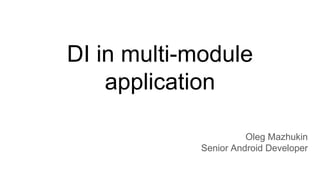
[Android] DI in multimodule application
- 1. DI in multi-module application Oleg Mazhukin Senior Android Developer
- 2. DI has many faces ● IoC – Inversion of Control ● DI(P) – Dependency Inversion Principle ● DI – Dependency Injection
- 3. Inversion of Control Design principle inverts the flow of control as compared to traditional control flow. E.g. To create user screen we extend Activity class with generic functionality can be selectively changed by additional user-written code i.e. Android framework provides custom-written portions of a computer program receive the flow of control from a generic framework
- 4. Dependency Inversion Principle ● High-level modules should not depend on low-level modules. Both should depend on abstractions (e.g. interfaces). e.g. Clean Architecture ● Abstractions should not depend on details. Details (concrete implementations) should depend on abstractions.
- 5. Dependency Injection Design pattern used to implement IoC. It allows the creation of dependent objects outside of a class and provides those objects to a class through different ways.
- 6. Design pattern vs design principle ● Design principles provide high level guidelines to design better software applications. They do not provide implementation guidelines and are not bound to any programming language. Examples: SOLID, GRASP ● Design Pattern suggests a specific implementation for the specific object- oriented programming problem i.e provides reliable solution in the specific context. Examples: Observer, Factory, Adapter, etc.
- 7. Multi-module application app module ● combines all feature modules ● provides common dependencies ○ OkHttpClient, RoomDao, Preferences, etc. feature modules ● contains feature specific module ● can have one of more scopes core modules ● utils/common module solutions
- 8. Do you need multi-module app? ● Modules can be reused in different apps ● Instant apps, app bundles ● Faster build time ( in theory ) ● Separate modules are more convenient for big developers teams
- 9. Creating our own DI Framework - injection implementation - same types/different target solution - lifecycle/visibility markes - providers
- 10. Meet JSR-330: javax.inject.* ● @Inject - target for dependency ● @Qualifier (i.e @Named ) - same types/different target solution ● @Scope (i.e @Singleton ) - lifecycle/visibility markes JSR-330 Implementations ● dagger2 ● spring ● toothpick
- 11. Component dependency vs submodules ● Submodules have access to all objects from all modules it possesses without an explicit declaration of those dependencies in the parent Component SubComponent plus(SubcomponentModule module) ● Component dependency requires explicit dependency declaration @Component( dependencies = [ComponentDependencies::class],.. ) interface Component {
- 12. Example app Features ● login ● content
- 13. Dagger graph ● Features ask for dependencies ● Feature can use common Injector or create its own ● App module provides dependencies ● Component destroyed based on lifecycle
- 14. App Module
- 17. Core Module
- 18. Core Module
- 19. Main App class
- 20. Main App class
- 22. Resolving common module dependencies ● moving dependency to app module ● moving dependency to core module ● using interfaces
- 23. Tips ● use feature prefixes ● don’t use direct feature dependencies ● split feature on data/feature modules ● use android free modules if possible ● use feature scopes only on objects with state ● use composite builds
- 24. Resources Google recommends https://developer.android.com/training/dependency-injection/dagger-multi-module Best Dagger Article https://habr.com/ru/post/279125/ Composite builds https://docs.gradle.org/current/userguide/composite_builds.html